This iconic dish is one of my personal favourites. Some would suggest it is the national dish of Thailand. I alway use it as a benchmark when trying out a new restaurant – if they get tom yum right, then there’s a good likelihood that the rest of their menu will be excellent too. There are a whole host of variants, with different meats, and secret ingredients. Which one I make very much depends on my mood.
The version with clear broth, without paste, has a fresh, clean taste, where you can really detect each of the individual ingredients in every mouthful. With this one, the heat normally takes some time to build.
By boiling some prawn heads in the broth, and then removing them before adding the rest of the ingredients, the broth becomes much richer. You can add tom yum paste, but it really isn’t necessary if using nice fresh aromatics. It’s crucial to taste as you go, to find out where you are with the seasoning – chef’s privileges! If you’ve added paste, the heat is likely to be quite intense.
Most commonly, the protein portion is prawns, but I’ve added some firm white fish as well ,to mix it up a little.
This recipe will serve 2 – 3.
Ingredients:
2 bowls full (the bowls you’ll be eating from) of water or stock
3 large sticks of lemongrass (not that dried rubbish they sell in Tesco’s for inflated prices)
a 2-3 inch piece of galangal
1 large shallot or several Thai shallots
10 – 20 Thai chillies
4 – 5 kaffir lime leaves
1 teaspoon of nam prik pao (roasted chillies in soya bean oil)
handful of cherry tomatoes, cut in half.
handful of oyster or straw mushrooms
8 prawns, shelled & butterflied (if not using fish, you’d need 16 – 18 prawns)
200 grams of firm white fish, cut into chunks (I use monkfish)
juice of 2 limes
5 – 8 splashes of fish sauce
a few sprigs of coriander or, preferably, sawtoothed coriander
Method:
1. Place the water/stock in a big saucepan. Turn the heat on to bring it up to a simmer.
2. Whilst the water is heating up, slice the galangal into thick slices and throw them in.
3. Bruise the lemongrass with the back of the cleaver and then cut into 2 inch long sections.
4. Peel the shallot and cut in half. Rip the kaffir lime leaves in half.
5. Cut the stem from the chillies and bruise them with the flat of the cleaver blade.
6. Add everything you’ve just prepared into the pot. Let it all simmer for about 5 mins.
7. Add the roasted chillies in soya bean oil. Stir.
8. Add the tomatoes and mushrooms. Stir.
9. As soon as it comes back up to the simmer, add the fish and the prawns. Simmer for literally 1 minute. Take off the heat immediately, or the prawn and fish will over cook and shrink to nothing.
10. Add a few dashes of fish sauce and juice from 1 lime. TASTE IT.
11. Does it need more fish sauce or lime? If so, add a bit more and taste. It should be a little salty, and quite sour, although how sour depends totally on how you like it. I like it sour, so 2 limes is normal for me. Having said that, not all limes are the same and not every bottle of fish sauce is the same. Taste and season, repeat…..
12. Once it’s tasting just how you like it, garnish with coriander and serve with rice.
13. Have some tissues handy as it will, most likely, be very hot.
